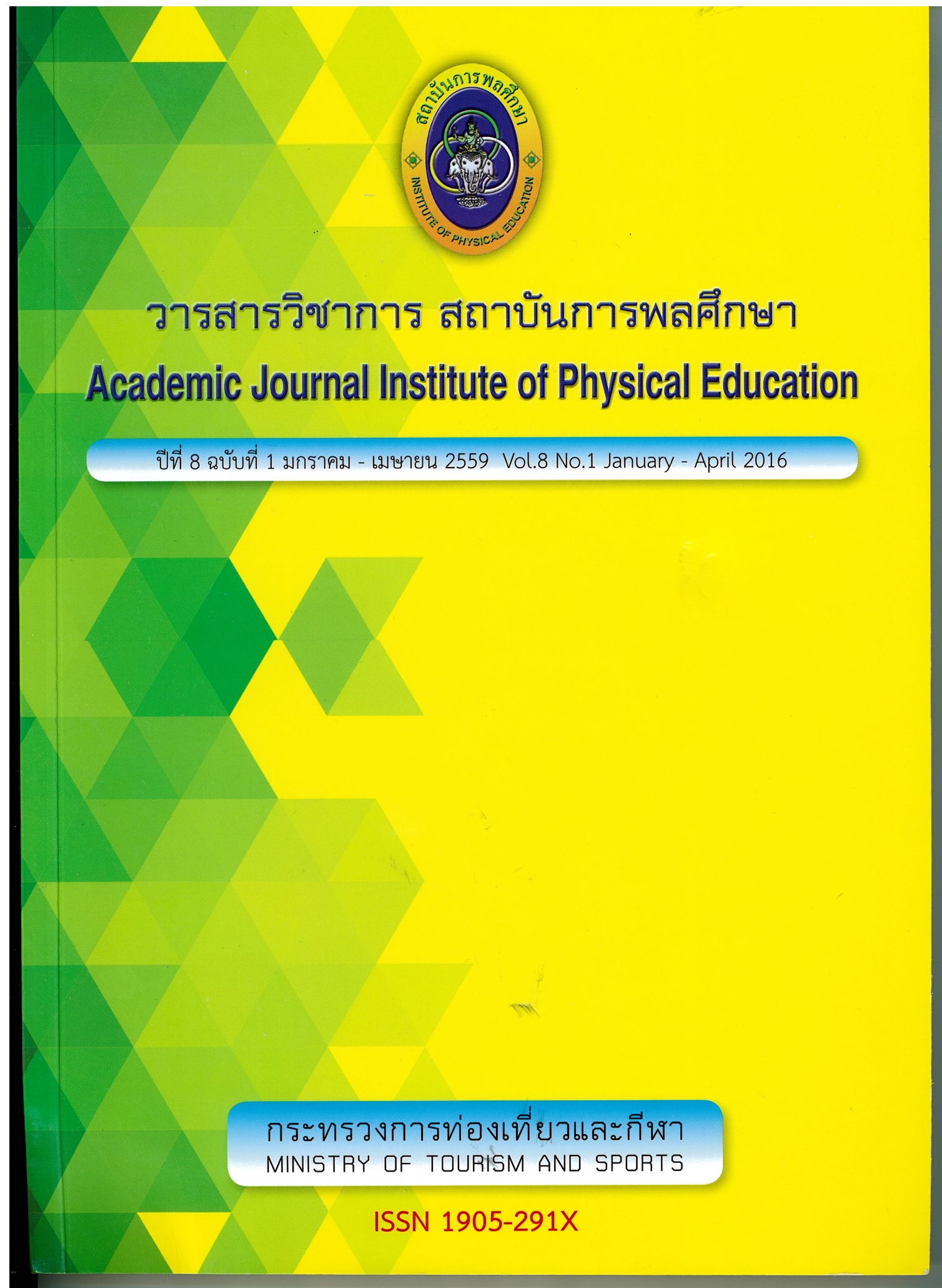Nutrition Status of Male Badminton Athletes of Thailand National Team
Main Article Content
Abstract
The purpose of this study was to assess the nutritional status of 16 males Thai badminton athletes. Nutrition status was assessed by a 3-day dietary record, anthropometry, biochemical, and hematological indices. It was found that means of body weight, height and percentage of body fat were 73+13 kg, 177+5 cm and 11.53+4.36 % , respectively. Mean energy and protein intake were 2601+512 kca/d, and 1.64+0.43 g/kg, respectively. The average intake from fat was 31.4+5.8% of total calories. Total energy and carbohydrate intake failed to meet minimum recommendation for athletes. There were found inadequate micronutrients intake, particularly vitamin C and calcium intake that lower than DRI recommendation whereas vitamin B group were meet adequate intake. Increase in creatine kinase was indicated sub-clinical muscular injury, increasing the potential for damage. The 87% of players were greater creatine kinase level than reference value. Conclusion: A high proportion of badminton players were not in energy balance, and failed to meet carbohydrate, vitamin C and calcium recommendations. Suboptimal nutrition status may affect physical performance.
Article Details

This work is licensed under a Creative Commons Attribution-NonCommercial-NoDerivatives 4.0 International License.
The published article is a copyright of the Academic Journal of Thailand National Sports University. The passage appeared in each article in this academic journal is a perspective of each author which is not related to the journal. Each author is required to be responsible for all components of his/her own article. If there are any mistakes, each author must be responsible for those mistakes on his/her own.
References
American College of Sport Medicine. (2000). The American Dietetic Association, and The Dietitians of Canada. Joint position statement: nutrition and athletic performance. Med Sci Sports Exerc, 32, 2130-2145.
Bergeron M.F., Volpe S.L., Gelinas Y. (1998). Cutaneous calcium losses during exercise in the heat regional sweat patch estimation technique. Clin Chem, 44(suppl), A167.
Clark M., Reed D.B., Crouse S.F., Armstrong R.B. (2003). Pre-and post-season dietary intake, body composition and performance indices of NCAA division 1 female soccer players. Int J Sport Nutr Exerc Metab, 13, 303-319.
Coelho D.B., Morandi R.F., de Melo M.A. et al. (2011). Creatine kinase kinetics in professional soccer players during a competitive season. Rev Bras Cineantropom Desempenho Hum, 13(3), 189-194.
Hunkin S.L., Fahrner B., Gastin P.B. (2014). Creatine kinase and its relationship with match performance in elite Australian Rules football. J Sci Med in Sport, 17, 332-336.
Jones B.H., Thacker S.B., Gilchrist J., Kimsey JrC.D., Sosin D.M. (2002). Prevention of lower extremity stress fractures in athletes and soldiers: a systemic review. Epidemiol Rev, 24, 288-347.
Knapik J., Montain S.J., McGraw S., Grier T., Ely M., Jones B.H. (2012). Stress fracture risk factors in basic combat training. Int J Sports Med, 33, 940-946.
Lambert E.V., Goedecke J.H. (2003). The role of dietary macronutrients in optimizing endurance performance. Curr Sports Med Rep, 2, 194-201.
Lappe J., Cullen D., Haynatzki G., Recker R., Ahlf R., Thompson K. (2008). Calcium and vitamin D supplementation decreases incidence of stress fractures in female navy recruits. J Bone Miner Res, 23, 741-749.
Manrique D.C., Gonzalez - Badillo J.J. (2003). Analysis of the characteristic of competitive badminton. Br J Sport Med, 37, 62-66.
McLellan C.P., Lovell D.L., Gass G.C. (2011). Biochemical and endocrine response to impact and collision during elite rugby league match play. J Strength Cond Res, 25(6), 1553-1562.
Mougios V. (2007). Reference intervals for serum creatine kinase in athletes. Br J Sports Med, 41(10), 674-678.
Papadopoulou S.K., Papadopoulou S.D., Gallos G.K. (2002). Macro- and micro- nutrient intake of adolescent Greek female volleyball players. Int J Sport Nutr and Exer Met, 12, 73-80.
Peternelj T.T., Coombes J.S. (2011). Antioxidant supplementation during exercise training: beneficial or detrimental? Sports Med, 41, 1043-1070.
Schutz Y., Kyle U.U.G., Pichard C. (2002). Fat free mass index and fat mass index pein Caucasian age 18-98 y. Int J Obes, 26, 953-960.
Yang Y. (2007). Application of serum CK and BUN determination in monitoring precompetition training of badminton athletes. J Huazhong Univ Sci Technolog Med Sci, 27(1), 114-116.
Young W.B., Hepner J., Robbins D.W. (2012). Movement demands in Australian rules football as indicators of muscle damage. J Strength Cond Res, 26(2), 492-496.


